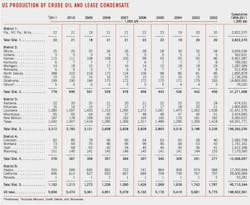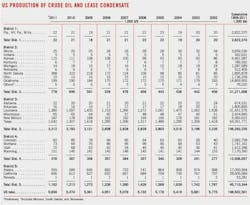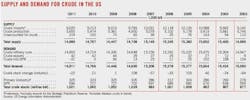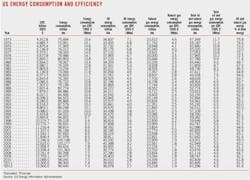US energy demand to stay weak in 2012 amid strong oil, gas production
View Article as Single page
In its latest Short-Term Energy Outlook, the US Energy Information Administration forecasts that this month's number of heating-degree days will also fall short of those a year earlier. The number of cooling-degree days is also expected to be above normal this summer.
The combination of a larger number of gas-fired plants in use for electric power generation and low gas prices will result in a 1.5% increase in gas demand this year, OGJ forecasts, and gas will comprise 25.4% of all energy used in the US.
Together, oil and gas will account for 61.6% of the US energy mix this year. This compares with a 61.5% share in 2011 and 61.8% in 2010. Oil's share, now holding steady at 36.3%, is down from 36.7% in 2010.
Coal demand in the US is declining due to electric power plant retirements in favor of natural gas. OGJ expects coal demand will decline by 2.4% this year to 20 quads.
The use of nuclear energy will rebound to 8.444 quads following last year's nearly 2% drop. Nuclear power generation in the US dipped in the second quarter of 2011 in the wake of the post-earthquake nuclear disaster at Japan's Fukushima power plant. This lull was short-lived, with US demand rebounding in the third quarter to 2010 levels, but the dip resulted in a decline in total 2011 nuclear demand to 8.285 quads.
Consumption of hydroelectric power and other renewable forms of energy will climb by 7.5% this year to 9.7 quads following last year's 11.3% surge. EIA reported that US hydropower generation in 2011 was poised to reach its highest level since 1999, primarily due to high precipitation in the Pacific Northwest.
Normal rain and snow this year will result in a decline in hydropower from last year's level, but other renewable energy sources will continue to climb, including wood, waste, and biofuels. Growth in wind energy, however, will slow this year with the expiration of production tax credits. Although it is growing, solar energy use in the US now totals only about 0.1 quads annually.
US oil supply
Crude and condensate production in the US will average 5.82 million b/d, climbing 3% from last year.
High oil prices and advanced hydraulic fracturing technology have spurred output increases in unconventional plays such as the Bakken shale as well as the Permian basin and the Eagle Ford shale's light tight oil.
IEA said last month that supply from the Eagle Ford shale has exceeded expectations, leading to a drop in demand for light sweet crude imports into the US Gulf Coast.
OGJ estimates that 2011 crude and condensate production increased in Texas by 26%, in North Dakota by 25%, and in New Mexico by 5%. Production declines were registered in Louisiana of 14% and in Alaska of 7%, although production from Prudhoe Bay is rebounding a bit.
Natural gas plant liquids production also will be up this year with development of prolific liquids-rich shale gas plays. OGJ forecasts a 2.4% increase in NGL output to 2.17 million b/d.
Displaying 4/7
View Article as Single page



